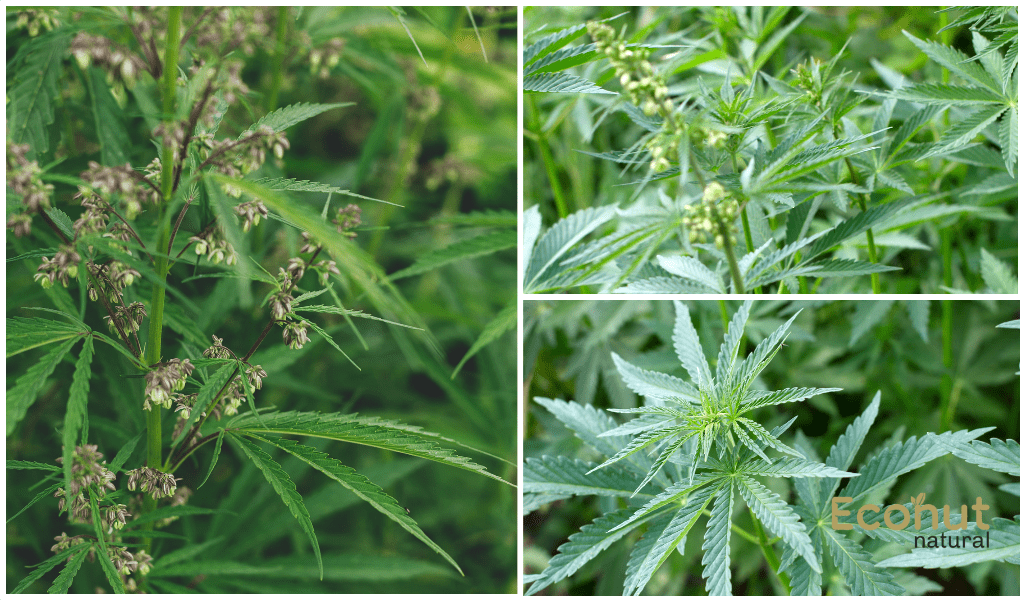Bhanga (Cannabis Sativa) is a paste formed from the buds and leaves of the Cannabis sativa plant. It might offer some protection against pain, vomiting, nausea, seizures, and spasms of the muscles.
Since ancient times, Ayurveda has employed bhang, or cannabis, to treat a variety of illnesses, cultivate fiber, and enhance rituals. In the medical area of the Vedas, this herb was known as Vijaya. It was employed as an inebriant in India circa 1000 BC. According to Atharvaveda, bhang is likewise regarded as a helpful herb that reduces worry and stress.
Description
Bhanga (Cannabis Sativa) is an annual herbaceous plant that typically reaches a height of 1 to 3 meters. It thrives in a variety of climates and is known to adapt to different environmental conditions. The leaves are palmate with serrated edges and are usually compound with 5 to 7 leaflets.
Botanical Name:
Cannabis Sativa
Family:
Cannabinaceae
Leaves:
The leaves are complex with five to seven leaflets and have a palmate shape with serrated edges.
Flowers:
The plant has unisexual Flowers; the female flowers are small and grouped, and the male flowers are tiny and pale green.
Root:
The fibrous root system
Taste:
Pungent (Katu), Bitter (Tikta)
Habitat:
Found in waste areas in the sub-Himalayan region (Native to central and western Asia)
Parts Used:
- Leaves
- Flowers (Ganja)
- Seeds
- Resins (Charas)
Varieties:
Cannabis Sativa.Cannabis indica
Dosage:
- Powder-125 to 250 mg
- Charas-30 mg
- Ganja-50 to 125 mg
Chemical Constituents:
Cannabis sativa is well-known for a variety of chemical components, including cannabinoids that have different pharmacological effects, such as delta-9-tetrahydrocannabinol (THC) and cannabidiol (CBD).
Botanical description
Cannabis sativa usually grows to a height of one to three meters. It can adapt to many climatic circumstances and grows well in a range of climates. The leaves are complex with five to seven leaflets and have a palmate shape with serrated edges.
Bhanga (Cannabis Sativa) Synonyms
- Vijaya
- Harita
- Indrasana
- Jayanti
- Ahiphena
- Madani
- Ganja
- Mundi
Other Language Names of Bhanga (Cannabis Sativa)
Spanish name – Cannamo, Canamo Indiana, Bhangane de la India
Bengali name – Siddi, Ganja, Bhang
Gujarati name – Bhag
Farsi name – Kinnab
Tamil name – Bangi, korkkamuchi, kalpam, Ganjam
Telugu name – Gunjai, Bhagiaku, Ganjachettu
Sweedish name – Tlamp
English name – Marijuana, Indian hemp
Hindi name – Charas and Bhang
Kannada name – Bhangi Soppu
Turkish name – Int heneviri
Sanskrit name – Vijaya,Ananda,Bahuvadini,Bhangi
Urdu name – Bhang,Ganja
Malyalam name – Kancabu,Kancha,Sivamuli,Cherukanchava
Manipuri name – Ganja
Marathi name – Bhang,Bhamgi,
Mizoram name – Kanja
Tibetain name – Myan Rtsi Spras
Persian name – Darakte-Bang,Darakhte-Bang
Chines name – Fuma Ma, Tama,Tang Ma
Burma name – Ben, Bin
Arabic name -Hinab,Kanab,Naba
Tunisia name – Korari
North Africa name – Kif
South Africa name – Dogga
America name – Marijuana
Scientific Classification
| Kngdom | Plantae |
| Subkingdom | Tracheobionta |
| Superdivision | Spermatophyta |
| Division | Magnoliopsida |
| Class | Magnoliopsida |
| Subclass | Hamamelididae |
| Order | Urticales |
| Family | Cannabaceae |
| Genus | Cannabis |
| Species | Sativa |
Ayurvedic Properties
Hindi/Sanskrit
- Rasa-Tikta
- Guna-Laghu,Teekshna,Vyavayi
- Virya-Ushna
- Vipaka-Katu
English
- Taste – Bitter-Bitter
- Physical Property-Light,Strong,Spread throut the body without
- First getting digested
- Potency- Hot-Hot
- Metabolic Property (After Digestion)-Pungent
Bhanga (Cannabis Sativa) Uses
Digestion:
Because bhang (Cannabis Sativa) is high in fiber, it aids in the digestive process and maintains regular bubble motions. Its insoluble fiber acts as a laxative and gives the feces more volume. The hemp seed shell contains the majority of the fiber. Therefore, it is preferable to eat it with the shell.
Skin:
Hemp seed oil has been shown to be effective in treating a variety of skin conditions, including psoriasis and eczema. This Koyal encourages the development of healthy cells by penetrating the skin’s layers. Hans can be utilized in cosmetic items such as lip balms, lotions, soaps, and more. It has the highest source of vitamin E.
Bhanga (Cannabis Sativa) Benefits
Excellent remedy for sleep problems:
Bhang was widely utilized to promote restful sleep, particularly for those who are unable to sleep due to fatigue, anxiety, or fear,” the Ayurvedic doctor explains.
Arthritis:
It assists arthritis sufferers in reducing pain and inflammation by acting as an analgesic and anti-inflammatory. The soil derived from its seeds maintains the stiff joints lubricated and robust.
Heart disease:
The highest concentration of arginine and linolenic acid may be found in its seeds, which immediately benefits the heart muscles and lowers the risk of heart disease. In addition to lowering blood pressure, this herb helps lower the chance of blood clot development.
Don’t miss: Nagarmotha (Cyperus Rotundus)- Uses, Benefits, Side Effects & More
Bhanga (Cannabis Sativa) Side Effects
A persistent cough:
The effects of inappropriate cannabis use on the lungs are comparable to those of tobacco smoke, and symptoms such as worsening cough and swelling phlegm might arise. Furthermore, if consumed over an extended length of time, this may cause dangerous lung diseases.
Reddened eyes:
After using a cannabis-based drug, like bhang, a person’s blood pressure and heart rate increase. This is mostly due to the plant’s cannabinoid-containing chemical components. The rise in heart rate and blood pressure is similar to the rise brought on by exercise. After some time, when blood pressure drops, the blood vessels and capillaries, particularly the veins in the eyes, enlarge. The increased blood flow to the eyes caused by this dilatation causes the person’s eyes to become red.
Tachycardia and hypotension:
Cannabis use puts those who already have a cardiovascular condition at higher risk. This is due to the fact that bhang can elevate postural hypotension, catecholamine levels, heart function, and hemoglobin levels.
Aridity of mouth:
Because of the effects of bhang on the neurological system, salivary flow is decreased. Extended exposure to this impact might result in the painful condition known as xerostomia, or dry mouth. It can also result in mouth sores and poor breath when ingested in high quantities.
Conclusion
This article concludes that heart, skin, and digestive ailments can be treated with bhang when taken at the recommended quantity. However, it should not be used on little children or during lactation. Before using bhanga, speak with your doctor as it might not have any negative impact on your health.
FAQS
Does Bhang have harmful effects?
Yes, cannabis has an impact on mental health. Additionally, there is a higher chance of mental disease if you become addicted to it. Depression, anxiety, mood disorders, sleep disorders, psychosis, and other mental health issues may be brought on by it.
How does Bhang affect the brain?
Though most people associate bhang with feelings of excitement, some users also report experiencing anxiety, fear, or depression. High or chronic cannabis usage, particularly when initiated at a young age, has been associated with increased rates of school dropout and worse levels of life satisfaction.
Does cannabis benefit the stomach?
Yes, because of its excellent digestive qualities, it is helpful for the stomach.
Can one eat bhang every day?
No, it shouldn’t be taken on a daily basis as it could impair coordination and short-term memory.

